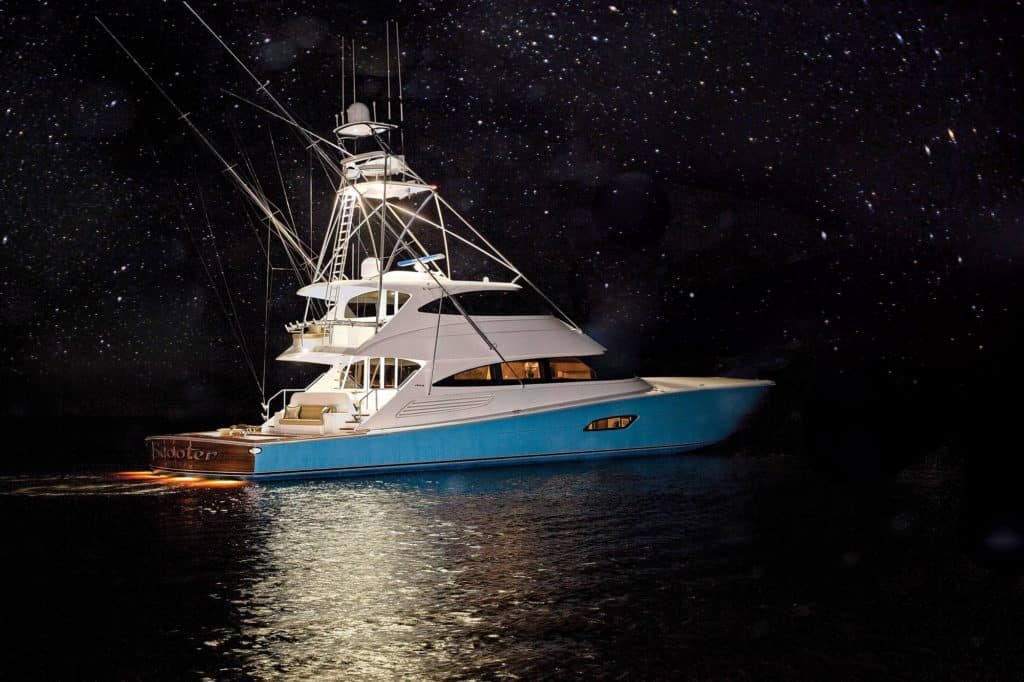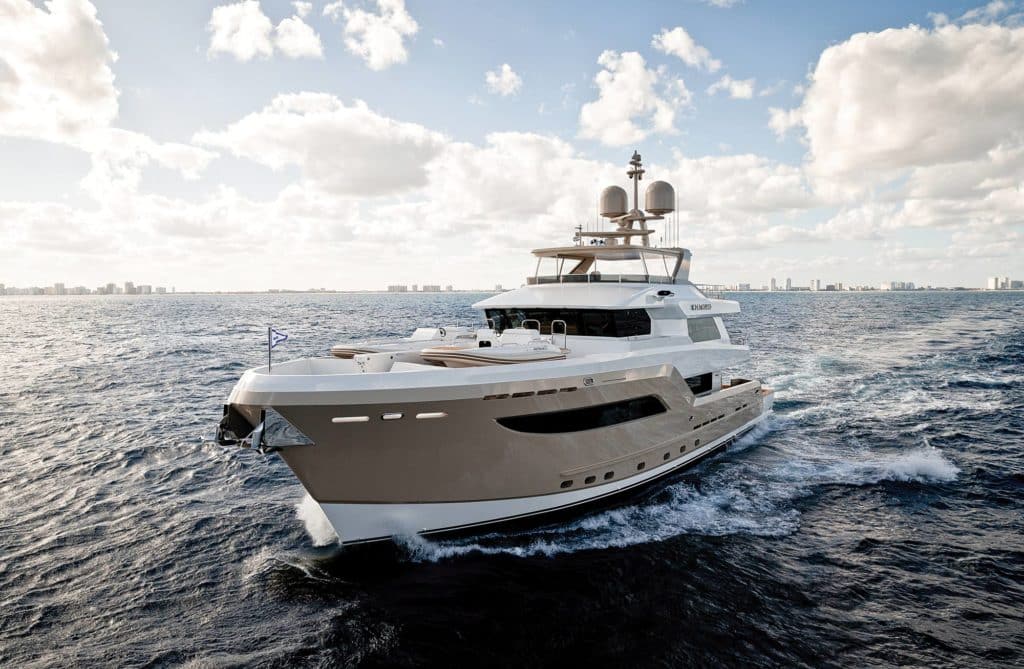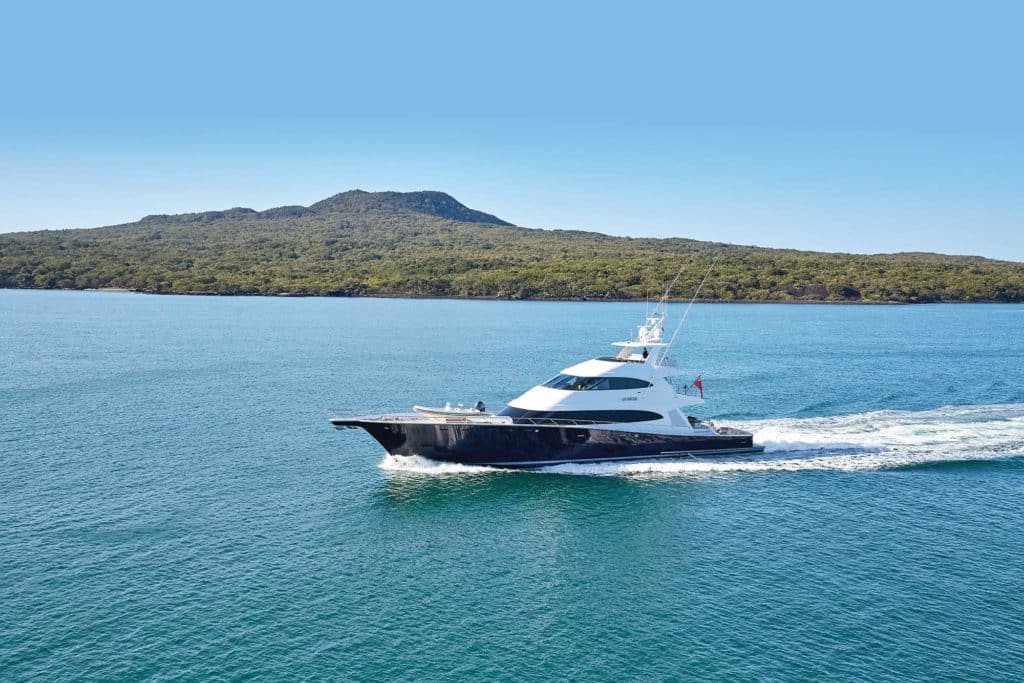
Once upon a time, sport-fishing boats were sized to meet lesser demands. Ernest Hemingway’s Pilar was 38 feet, which was large enough to get him into the Gulf Stream to chase marlin and the occasional U-boat during World War II. The first Rybovich, Miss Chevy II, was just 34 feet long, while the first Hatteras convertible sport-fisher, Knit Wits, pushed the length-overall envelope at 41 feet some 60 years ago.
Today, sport-fishers have soared past the 90-plus-foot mark with regularity, ranging up to the 144-foot Trinity Bad Company (originally Marlena) that carries a dozen guests and a half-dozen crew on adventures to far-flung fishing grounds.
For years, both production and custom-built sport-fishers have grown. Owners demanded vessels that were bigger and more comfortable for running on their own bottoms from the United States to the fertile Pacific waters of Costa Rica and Guatemala to chase supersize sailfish and blue, black and striped marlin. To chug across the Atlantic for the summer billfish tournaments in Bermuda. To chase world records, wherever the bite was at the moment. It’s an attitude reminiscent of the film Endless Summer, where surfers gallop around the planet in search of the perfect wave.
The builders Viking, Hatteras and Bertram have long been the 900-pound gorillas of production sport-fishers, drawing the line at around 90 feet, with the Viking 92 emerging as a front-runner in this category. To date, Viking has built 19 of its 92-footers, with hull numbers 20 and 21 currently in production. While the Hatteras 92 and Bertram 80 are out of production, they still enjoy popularity on the brokerage market.
On the custom, cold-molded construction side of sport-fish yachts, North Carolina’s Jarrett Bay Boatworks launched the 90-foot Jaruco in 2017. The boat is a 44-knot battlewagon with a foredeck for touch-and-go helicopter landings. And for those who believe wooden hulls raise more fish, Bayliss Boatworks—also in North Carolina—has the 90-foot Reel Wheels II, with five staterooms and 38-knot speed, making quick work of runs to the canyons or back to the scales on tournament day.
In general, the hallmarks of a great sport-fisher, at least those in the 40-to-60-foot range, have included nimbleness when fighting a fish, as well as speed. Today’s larger sport-fishers can compete in those areas as well.

Consider the 92-foot Viking Fa La Me, owned by Frank Rodriguez. It swept the Bermuda Triple Crown tournament series with the highest point total in the event’s history and became the first three-time winner of the series. Another 92-foot Viking, A Work of Art, grabbed second place in the 2017 Orange Beach Billfish Classic release division, and the 95-foot Jim Smith Relentless Pursuit took the tournament in 2019 with a 658.2-pound blue marlin and third-place wahoo.
The reigning queen of the mega-sport-fisher world, though, continues to be Bad Company, which was at first 132 feet length overall and subsequently stretched. Its top speed with twin 3,500 hp Paxman V-12s is 33 knots, which at first blush may not seem special. Keep in mind, however, that a 300-gross-ton 144-footer traveling at 33 knots can maintain that speed in rough seas while smaller, albeit faster sport-fishers have to pull the throttles way back. The amount of hull in the water matters.
The newest of the big-gun sport-fishers is the 130-foot Lanakai. Michael Peters designed it, and New Zealand’s Yachting Developments built it. It is the largest carbon-fiber sport-fisher and has twin 3,150 hp V-12 MTU 4000 M93 diesels that reportedly push it to 30 knots while carrying 10 guests and six crew in superyacht style.
So what changed to make larger sport-fishers tournament-viable, aside from owners being willing to spend considerably more money on a bigger boat?
First, of course, is maneuverability, which is essential—especially when faced with an angry blue marlin. Hydraulic bow thrusters are a key component of these vessels, allowing a captain to position the yacht precisely when backing down hard. Captains describe the big sport-fishers as being just as nimble as smaller boats.
On Fa La Me, one of the secret weapons is the fly-by-wire Viking independent programmable electrohydraulic rudders, eliminating the tie bars between rudders, and allowing independent rudder control, much like pod drives but with conventional shafts and props. The setup optimizes maneuverability at low speeds. Add to that modern technology such as joystick controls, which make the captain’s job easier. Two fingers on a joystick on the bridge rail keeps the yacht perfectly positioned for the crew in the cockpit.
Available horsepower has also driven up the sport-fisher’s length overall, with up to 7,000 hp now tucked into engine rooms for hammer-down power. Add in other technology such as gyrostabilizers that make a yacht more secure for stand-up tackle, and the result is large sport fishing yachts that are as agile as smaller sport-fishers in the hands of an experienced helmsman.

Sheer size has other benefits. Consider the cockpit on Bad Company, which spans the vessel’s 27-foot beam. A half-dozen crew can be prepping bait and rigging lines and leaders, and never be crowded. That same width also allows outriggers that spread 120 feet to get lines into clean trolling lanes.
Mega-sport-fishers also have more balconies and mezzanines than Italy’s La Scala opera house, so it’s easier to keep a eye on the spread. Three decks on most offer good viewing of the fishing action. And the height matters. A taller flybridge allows for better visibility than tuna towers on smaller craft.
Larger yachts also mean more rod-and-tackle stowage and immense fridges and freezers with multiple ice chippers to keep the catch fresh and cool. Enclosed bridges provide comfort on extended passages as well as weather protection on snotty days.
The owner of Lanakai, according to Peters, puts those and other features to good use. “This owner is an absolute sportsman and adventurer,” Peters says. “He wants to stay out for weeks. He wants to fish Fiji and the [Great] Barrier Reef. He wants to roam far and wide in search of big fish. He had an 85-footer, and it simply wasn’t big enough for his goals. Besides, it’s not just about fishing; a water-level cockpit gives great access to the water for diving too.”
This type of boat is indeed a beautiful thing. As Luiz de Basto, designer of the 105-foot Broward Odyssey and the 95-foot Seaforce IX sport-fisher series, puts it: “Something that I, as a yacht designer, realized many years ago is that the pure, classic fishing boat—its unique purpose and the resulting lines—are probably the most original creation of the vast and diverse American pleasure-boat universe. From 30-footers to the largest ones, they all share a sporting purpose and beautiful elegance that demonstrates America’s ingenuity at its best.”
The style also represents fishing at its finest. Sam Gershowitz—owner of the Star Island Yacht Club and Marina in Montauk, New York—is a serial owner of sport-fishers, all named Marlena. His current big gun is a 105-foot Jim Smith. When asked how he planned to fish the boat, his answer perfectly summed up mega-sport-fishers: “very comfortably.”









